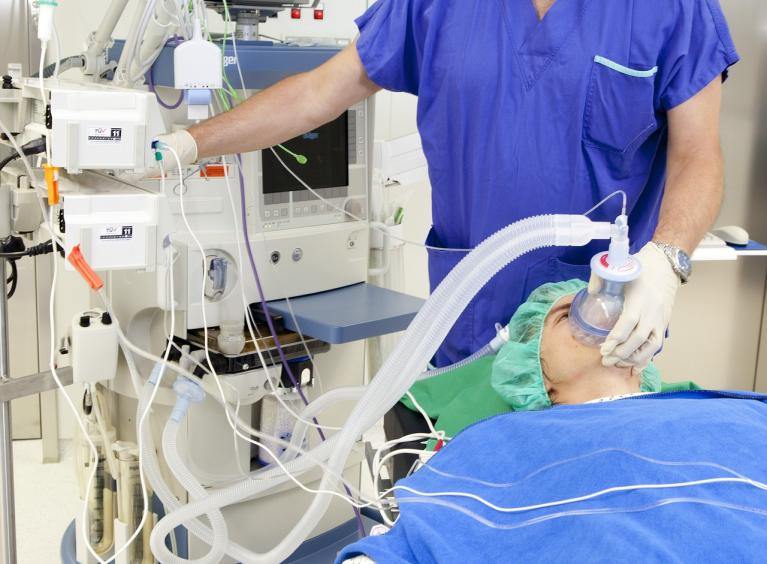Anaesthetic Department
The Anaesthetic team provide anaesthesia to allow patients to tolerate operations and procedures in comfort and safety. This may be a local anaesthetic where the patient may remain awake, a local anaesthetic with sedation to make the patient drowsy or a full general anaesthetic where the patient will be asleep.

Healthcare provided
Anaesthetists work with many teams in the hospital. Anaesthetists work alongside surgical teams in the main and day surgery theatres, providing anaesthetic support for women in labour and with the help of an acute pain team, provide pain relief to patients who need it after an operation.
The department also provides anaesthetic staff to the intensive care unit and a specialist outreach team helps medical staff with the care of sicker patients on the wards.
All patients coming into Barnsley Hospital for surgery are pre-assessed in our dedicated pre-assessment unit by experienced nursing sisters, this is to make sure you are fit for surgery and anaesthetic.
If you are having a general or local anaesthetic, please read our guide about how to prepare and what to expect.
If your child is having an anaesthetic, you can find out how to prepare and what to expect for a child receiving anaesthetic.
Get in touch
Call our secretaries on
01226 432917
Clinical Care Outreach Team
The critical care outreach team assists the ward staff to treat the sicker patients within the wards. They use a scoring system to spot patients as early as possible who need additional support.
By recognising patients early who are deteriorating, measures can be put in place early to turn their problems round. For those who become increasingly unwell, the outreach team can quickly move them to the intensive care unit.
Women in labour
The anaesthetic department provides support to the labour ward and provides pain relief via an epidural injection and analgesia for caesarean sections.
Epidural
An epidural is a special type of local anaesthetic procedure. It numbs the nerves which carry the feeling of pain from the womb and the birth canal to the brain. There may be a need to discuss suitability of this method of pain relief with an anaesthetist early in pregnancy especially if you have any medical, skeletal or allergy problems. For most women an epidural gives good pain relief in labour, but occasionally it may not work effectively. Please see below for further guidance:
- it may take up to half an hour to complete
- it is done by a specialist doctor called an anaesthetist
- occasionally there may be a delay if there is an emergency on labour ward, or if another person requires an epidural for medical reasons
- the epidural is inserted with you either sitting or lying on your side, the anaesthetist inserts a fine plastic tube through a needle in between the bones of your spine and the needle is withdrawn leaving the fine plastic tube in place. This is secured in place with a dressing until the baby is born. Local anaesthetic can then be injected through the fine plastic tube
- in some cases of assisted delivery for example caesarean section or instrumental delivery the same epidural can be used to give stronger local anaesthetic drugs to deliver the baby
- in rare circumstances spinal anaesthetic may be considered instead - your anaesthetist will discuss this with you
- your legs may feel heavy and you will not be able to get out of bed because of this heaviness during labour, possibly for a few hours later
- you may find it difficult to pass water. A small tube called a catheter may be passed into your bladder to help you
- before the epidural is started you need to have a drip inserted into a vein in your hand. This helps to control your blood pressure
- you will be advised to have your contractions, and baby’s heart beat, continuously monitored by a machine called a cardiotocograph (CTG)
- for delivery if you do not feel your contractions, the midwife will guide you when to push
- there is evidence that epidurals do not cause backache, even though there may be localised tenderness for 2 – 3 days
- you will be recommended to and encouraged to change position frequently to prevent your bottom getting sore
- there is some possibility (1/200) of getting a severe headache after insertion of an epidural. Your anaesthetist will discuss this possibility and treatments with you
- there is evidence that having an epidural too early in labour may increase your chances of having an assisted delivery. It may be wise to use this option of pain relief when labour is well established (4cm or more dilated)
Caesarean sections
Caesarean section, also known as c-section, is the use of surgery to deliver one or more babies. A caesarean is often performed when a vaginal delivery would put the baby or mother at risk.
Most caesareans are done under regional anaesthesia, when you are awake but sensation from the lower body is numbed. It is usually safer for mother and baby and allows both you and your partner to experience the birth together.
Types of regional anaesthesia
Spinal / Epidural – the most commonly used method. It may be used in planned or emergency caesarean section.
Combined spinal-epidural or CSE – a combination of the two. The spinal can be used for the caesarean section. The epidural can be used to give more anaesthetic if required, and to give pain-relieving drugs after the operation.
General anaesthesia – if you have a general anaesthetic you will be asleep for the caesarean section. General anaesthesia is used less often nowadays. It may be needed for some emergencies; if there is a reason why regional anaesthesia is unsuitable or if you prefer to be asleep. The pros and cons of each will be explained to you by the anaesthetist.
